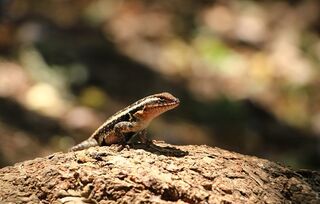How The Brain Evolved
Your inner self needs a LOT of attention!
by Rick Hanson Ph.D.
Down deep, do you feel at ease?
The Practice:
How the brain evolved.
Why?
I've always liked lizards.
Growing up in the outskirts of Los Angeles, I played in the foothills near our home. Sometimes I'd catch a lizard and stroke its belly, so it would relax in my hands, seeming to feel at ease.
In my early 20's, I found a lizard one chilly morning in the mountains. It was torpid and still in the cold and let me pick it up. Concerned that it might be freezing to death, I placed it on the shoulder of my turtleneck, where it clung and occasionally moved about for the rest of the day. There was a kind of wordless communication between us, in which the lizard seemed to feel I wouldn't hurt it, and I felt it wouldn't scratch or bite me. After a few hours, I hardly knew it was there, and sometime in the afternoon it left without me realizing it.
Now, years later, as I've learned more about how the brain evolved, my odd affinity for lizards has started making sense to me. To simplify a complex journey beginning about 600 million years ago, your brain has developed in three basic stages:
- Reptile - Brainstem, focused on avoiding harm
- Mammal - Limbic system, focused on approaching rewards
- Primate - Cortex, focused on attaching to "us"
Of course, the brain is highly integrated, so these three key functions - avoiding, approaching, and attaching - are accomplished by all parts of the brain working together. Nonetheless, each function is particularly served by the region of the brain that first evolved to handle it. This fact has significant implications.
For example, in terms of avoiding harm, the brainstem and the structures just on top of it are fast and relatively rigid. Neuroplasticity - the capacity of the brain to learn from experience by changing its structure - increases as you move up both the evolutionary ladder and the layered structures of the brain.
Consequently, if you want to help yourself feel less concerned, uneasy, nervous, anxious, or traumatized - feelings and reactions that are highly affected by "reptilian," brainstem-related processes - then you need many, many repetitions of feeling safe, protected, and at ease to leave lasting traces in the brainstem and limbic system structures that produce the first emotion, the most primal one of all: fear.
Or to put it a little differently, your inner iguana needs a LOT of petting!
How?
To begin with, I've found it helps me to appreciate how scared that little lizard inside each one of us is. Lizards - and early mammals, emerging about 200 million years ago - that were not continually uneasy and vigilant would fail the first test of life in the wild: eat lunch - don't be lunch - today.
So be aware of the ongoing background trickle of anxiety in your mind, the subtle guarding and bracing with people and events as you move through your day. Then, again and again, try to relax some, remind yourself that you are actually alright right now, and send soothing and calming down into the most ancient layers of your mind.
Also soothe your own body. Most of the signals coming into the brain originate inside the body, not from out there in the world. Therefore, as your body settles down, that sends feedback up into your brain that all is well - or at least not too bad. Take a deep breath and feel each part of it, noticing that you are basically OK, and letting go of tension and anxiety as you exhale; repeat as you like. Shift your posture - even right now as you read this - to a more comfortable position. As you do activities such as eating, walking, using the bathroom, or going to bed, keep bringing awareness to the fact that you are safe, that necessary things are getting done just fine, that you are alive and well.
Throughout, keep taking in the good of these many moments of petting your inner lizard. Register the experience in your body of a softening, calming, and opening; savor it; stay with it for 10-20-30 seconds in a row so that it can transfer to implicit memory. (For more on how to take in the good and defeat the innate negativity bias of the brain - whose unfortunate default setting is to be Velcro for negative experiences but Teflon for positive ones - go to this link.)
Some have likened the mind/brain to a kind of committee. Frankly, I think it's more like a jungle! We can't get rid of the critters in there - they're hardwired into the brain - but we can tame and guide them. Then, as the bumper sticker says, they wag more and bark less.
Or relax, like a lizard at ease in the sun.
Like this article? Receive more like it each week when you sign up for Rick Hanson's free Just One Thing Newsletter.